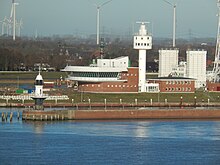German coast security concept
The German coast security concept ensures the defense against dangers to the safety and ease of traffic as well as dangers from shipping on the German coast through primarily preventive, sovereign measures . The success of this concept is reflected in the low accident rate in the entire German territorial sea. This was reduced to 0.0035 percent in the German Bight with an annual traffic volume of around 65,000 reportable ships (larger than 50 m). The same applies to the German Baltic Sea, despite the currently significant increase in shipping traffic from Eastern Europe.
Competent Authorities
As the authorities of the Federal Waterways and Shipping Administration (WSV), the General Direction for Waterways and Shipping and the subordinate Waterways and Shipping Offices are responsible for the safety and ease of traffic as well as the prevention of dangers at sea from shipping. On the basis of these tasks, the shipping departments of the aforementioned waterways and shipping directorates developed the traffic safety concept "German Coast", which consists of various modules and ensures safety on the German coast with its preventive measures to avert danger.
target
The primary goal of the Waterways and Shipping Directorates and their subordinate offices is to use preventive measures to ensure the safety and ease of traffic and to prevent dangers and in particular disruptions from occurring in the first place.
Modules

The traffic safety concept contains the following modules:
1. Traffic routing
- Traffic separation areas
- Fairway facility
- Determination of shipping routes
2. Navigation signs
- Lateral designation of the traffic routes
- Cardinal designation of obstacles to navigation
- Installation of navigation aids in the form of fixed navigation signs
3. Traffic regulations
- Application, co-creation and maintenance of the shipping route regulations (SeeSchStrO)
- Announcements on the SeeSchStrO
- Issuance of driving regulations
- Ordinance on restricted and warning areas
4. Notification obligations of shipping
- in accordance with the regulations governing the starting conditions and the regulations on shipping routes
5. Maritime pilotage
- Application, co-creation and maintenance of the Maritime Pilot Act
- Publication of the district pilot regulations
- Publication of pilot regulations outside of the areas
6. Maritime traffic safety
- Establishment and operation of traffic control centers
7. Accident management
- Availability of emergency towing capacity
- Traffic-related fire protection
- Pollution control
- Elimination of malfunctions (accidents)
8. Electricity and shipping police individual measures by the water and shipping authorities
- Issuing permits, exemptions and dispositions
9. Shipping police enforcement
- Measures of your own administration
- Agreements and agreements with the water police , customs and the federal police
10. Cooperation with neighboring countries
- Collaboration in accident management
- Cooperation in maritime traffic safety
- Cooperation in traffic routing
11. Maintaining the federal waterways in a condition required for shipping
- Maintenance and operation of the waterways and state-owned facilities and ports
- Expansion and construction of the federal waterways
- Exercise of electricity police duties
12. Maritime Security
- Establishment and operation of the point of contact
- ISPS security measures for the Kiel Canal
